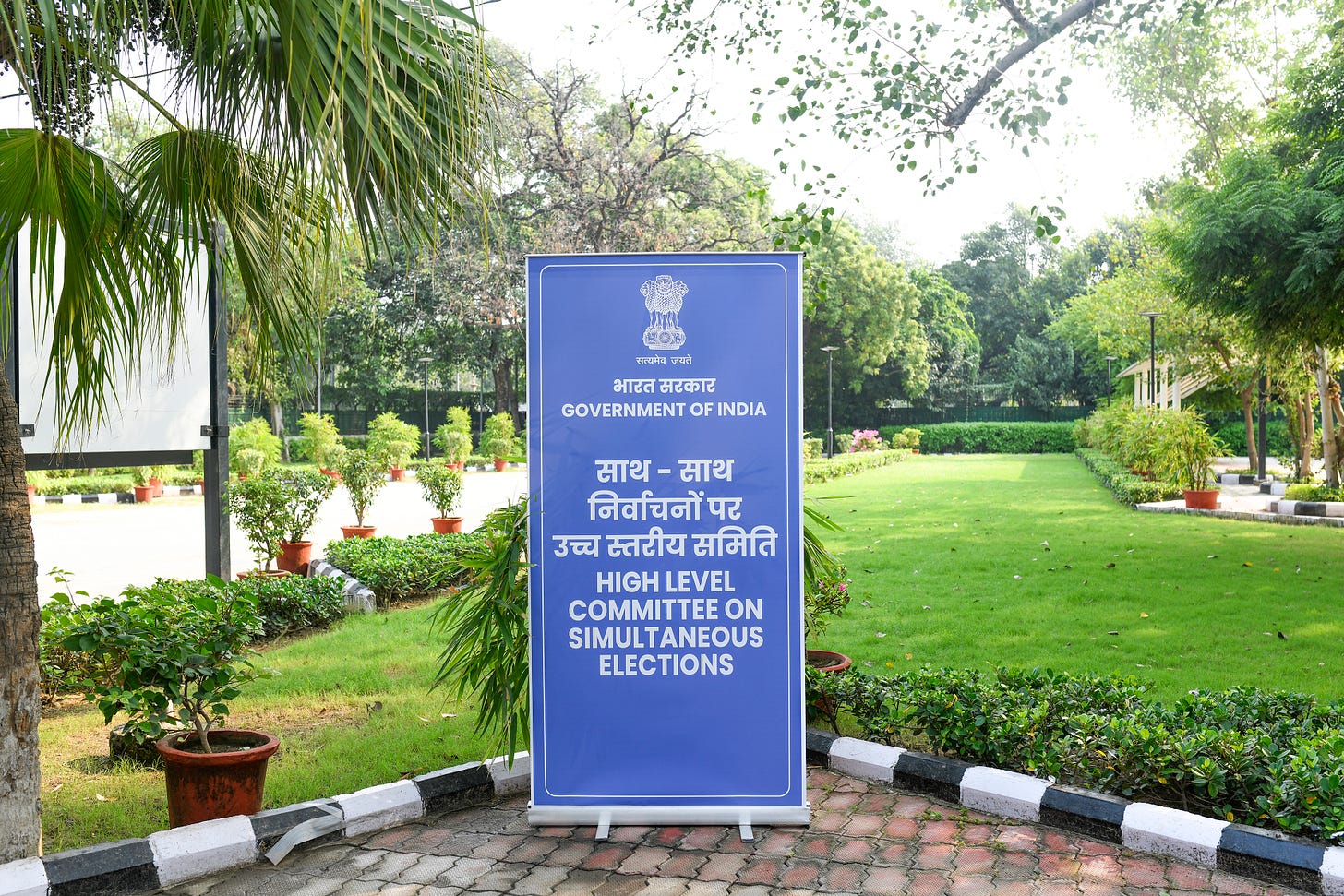"One Nation, One Election": Union Cabinet Accords In-principle Approval
The Cabinet Accepts the Recommendations of the High-Level Committee on Simultaneous Elections, but a Challenging Road Lies Ahead as Special Constitutional Amendments Will Be Required.
Cabinet Accepts Recommendations of High-Level Committee on Simultaneous Elections
Crucial Cabinet Approval
The Union Cabinet, chaired by Prime Minister Shri Narendra Modi, has accepted the recommendations of the High-Level Committee on Simultaneous Elections. Headed by the former President Shri Ram Nath Kovind, the Committee has delineated a comprehensive framework for implementing simultaneous elections in India, commonly referred to as 'One Nation, One Election.' This proposal seeks to streamline the electoral process by reducing the frequency of elections at all levels, including the Lok Sabha, State Legislative Assemblies (Vidhan Sabhas), and local bodies such as the Urban Local Bodies and the Panchayati Raj Institutions.
Simultaneous Elections: A Historical Overview
India initially conducted simultaneous elections from 1951 to 1967. However, due to various constitutional and political developments, the electoral cycle for the Lok Sabha and State Legislative Assemblies diverged, leading to the current practice of staggered elections. The idea of simultaneous elections was first revived by the Law Commission in its 170th Report (1999), which proposed conducting elections to the Lok Sabha and all State Legislative Assemblies simultaneously every five years. Later, a Parliamentary Committee’s 79th Report (2015) recommended a phased approach for implementing this system.

High-Level Committee: Formation and Stakeholder Consultations
The High-Level Committee, chaired by Shri Ram Nath Kovind, was tasked with studying the feasibility of simultaneous elections and offering practical recommendations. The Committee held extensive consultations with stakeholders, including 47 political parties, citizens, legal experts, and business organisations. Out of the political parties consulted, 32 supported simultaneous elections, and 80% of the 21,558 citizens who provided feedback were in favour of the proposal.
The Committee also engaged with eminent legal experts, including four former Chief Justices of India and twelve former Chief Justices of High Courts. Additionally, it sought the views of the Election Commission and leading economic bodies such as CII, FICCI, and ASSOCHAM, which emphasised the economic benefits of holding simultaneous elections.
Key Recommendations of the High-Level Committee
The High-Level Committee has recommended a two-phase approach to implement simultaneous elections:
First Phase: Simultaneous elections will be conducted for the Lok Sabha and State Legislative Assemblies.
Second Phase: Elections to municipalities and panchayats will be synchronised with the general elections, to be held within 100 days of the Lok Sabha and Assembly elections.
Additionally, the Committee proposed the use of a common electoral roll for all elections and advocated for the synchronisation of electoral rolls across all levels of government.
Amendments to Implement the Simultaneous Elections Proposal
To bring simultaneous elections into effect, several constitutional amendments and statutory changes would be required. The key amendments proposed include:
Amendment to Article 83: This article, which defines the duration of the Houses of Parliament, would need to be modified to allow for the synchronisation of Lok Sabha terms with those of the state legislative assemblies.
Amendment to Article 172: Similar changes would be required in this article, which pertains to the duration of state legislative assemblies, to align their terms with the Lok Sabha.
Amendments to Articles 85 and 174: These articles, which deal with the dissolution of the Lok Sabha and state assemblies, respectively, would require amendments to allow for coordinated dissolution and elections.
Amendment to Article 356: The provisions related to President's Rule in states might need modification to prevent disruption of the simultaneous election cycle.
Amendments to Part XV: This part of the Constitution, which deals with elections, may require amendments to incorporate provisions for simultaneous elections.
Constitutional Amendments and the Path to Simultaneous Elections
To implement simultaneous elections, several constitutional amendments will be necessary, which would likely need to be passed under Article 368. This article requires a special majority in both Houses of Parliament, meaning more than 50% of the total membership must approve the amendment, along with a two-thirds majority of those present and voting. However, certain amendments will also require ratification by at least 50% of the state legislatures, as specified in Article 368(2) of the Constitution.
The amendments needing state ratification typically pertain to the federal structure of the Constitution, particularly issues like the division of powers between the Union and the States. Specifically, amendments related to Articles 54, 55, 73, 162, 241, and 279A, as well as certain chapters and lists, such as Chapter IV of Part V, Chapter V of Part VI, and Chapter I of Part XI, will require this additional level of approval. These provisions also cover the representation of states in Parliament and the amendment process itself under Article 368.
For amendments that do not fall under these categories, only the special majority in Parliament is needed, without requiring ratification from the state legislatures. However, given the significance of simultaneous elections, which touch upon the balance of power between the Union and the States, building national consensus will be crucial. Like the recent passage of the Women's Reservation Bill, pushing through such amendments in a politically divided environment may prove challenging. A united political approach will be essential to ensure the smooth implementation of this transformative electoral reform.
Economic and Social Benefits of Simultaneous Elections
The Committee's consultations with leading business organisations highlighted the adverse effects of frequent elections on economic growth and governance. Staggered elections disrupt economic activities, divert resources, and affect the quality of public services. Simultaneous elections, on the other hand, would lead to economic stability and better governance, as governments would not be perpetually engaged in election-related activities.
By holding elections simultaneously, the government would also be able to streamline public expenditure, especially in critical sectors like education and healthcare, without the interruptions caused by frequent electoral processes.
Constitutional Amendments and Legal Adjustments
The Committee was meticulous in ensuring that its recommendations align with the existing constitutional framework. Only minimal amendments would be necessary to implement the proposal, preserving the spirit of the Constitution while facilitating this significant reform. Introducing a fixed term for legislatures may also be required to guarantee the smooth functioning of simultaneous elections. However, the challenges posed by the legislative process, and the possibility of elections falling out of sync due to unforeseen political developments, as we will explore in the following sections, cannot be entirely dismissed.
Challenges of Synchronisation in State Legislative Assemblies
While the proposal for simultaneous elections appears to offer many practical benefits, such as reducing the frequency of elections and streamlining governance, there are significant apprehensions about its long-term viability. One key concern is the potential for synchronisation to fall out of step, especially in the case of state legislative assemblies. If a state government loses its majority or experiences a split verdict, the suggestion of placing the state under President's Rule for the remainder of the term would pose a serious threat to India's democratic structure. Prolonged central rule, without the people's mandate, could undermine the federal balance and diminish the autonomy of state governments, which are meant to reflect the will of the electorate.
Instability at the Union Level and Its Impact on Synchronisation
On the other hand, the situation at the Union level presents different challenges. In the event of a split verdict in the Lok Sabha, there is no provision for President's Rule at the Centre. A caretaker government, which lacks the authority to pass essential legislation such as the budget, would be impractical and could lead to a governance crisis. While recent Lok Sabha elections have yielded stable majorities, history reminds us that this has not always been the case. The divided mandates of the 1996, 1998, and 1999 elections serve as a warning that such instability could occur again, disrupting the synchronised election cycle. In such cases, fresh elections for the Lok Sabha would need to be held promptly, breaking the intended alignment between national and state elections. This fundamental uncertainty raises doubts about whether simultaneous elections, though desirable in theory, can remain sustainable in practice. It is imperative that political leaders across the spectrum carefully consider these potential disruptions before pushing forward with the reforms.
Next Steps for Implementing One Nation, One Election
With the Union Cabinet accepting the recommendations, the Government will initiate a nationwide consultation process to build consensus around the proposal. An implementation group will be formed to oversee the transition to simultaneous elections. This group will coordinate efforts across various administrative and legislative bodies, ensuring that the necessary constitutional and statutory changes are made in a timely and efficient manner.
Conclusion: Charting India’s Path to Simultaneous Elections
The Cabinet's decision to accept the High-Level Committee's recommendations1 marks a significant step toward the realisation of the "One Nation, One Election" initiative. The proposal has garnered strong support from political parties, citizens, and economic experts alike. If implemented, simultaneous elections have the potential to significantly improve governance, enhance transparency, and promote economic stability. By reducing the frequency of elections, this reform could streamline India’s democratic processes and contribute to the nation’s long-term development goals.
However, the legislative process, particularly the constitutional amendments required, will remain challenging and cannot be achieved without broad political consensus across party lines. Additionally, the possibility of future political instability leading to a re-emergence of asynchronous elections cannot be entirely ruled out. Despite these challenges, this is an important first step. As citizens of the world's largest democracy, we should welcome this initiative, while remaining mindful of the complexities and hurdles that lie ahead2.
Based on the report from the High-Level Committee on One Nation One Election, here are the main recommendations:
## Constitutional Amendments
The committee recommends amending the Constitution to facilitate simultaneous elections[1]. This includes:
- Inserting new articles 324A and 324B to enable simultaneous elections
- Amending articles 83, 85, 172, 174, and 356 to align terms of legislatures
- Adding a new schedule (Fourth A Schedule) to specify the term of legislatures
## Electoral Reforms
**Constructive Vote of No-Confidence**
The report suggests introducing a constructive vote of no-confidence, where an alternative government must be in place before voting out the existing one[1].
**Fixed Terms for Legislatures**
It recommends fixed terms for Lok Sabha and State Legislative Assemblies, typically lasting the full 5-year term[1].
## Implementation Strategy
The committee proposes a two-phase implementation:
1. Synchronize Lok Sabha, State Legislative Assembly, and Union Territory Assembly elections by 2029
2. Include elections to Municipalities and Panchayats by 2034[1]
## Legal Framework
The report recommends enacting a new law called "The Simultaneous Elections Act" to provide a comprehensive legal framework for conducting simultaneous elections[1].
## Logistical Considerations
**Electronic Voting Machines (EVMs)**
The committee suggests using separate EVMs for different levels of elections to maintain clarity and ease of voting[1].
**Security Measures**
Enhanced security arrangements are recommended to ensure free and fair elections across the country simultaneously[1].
These recommendations aim to streamline the electoral process, reduce costs, and improve governance efficiency in India through the implementation of simultaneous elections at various levels of government[1].
Citations:
[1] https://onoe.gov.in/HLC-Report-en
https://onoe.gov.in/HLC-Report-en (Click to read the 322 page report)





